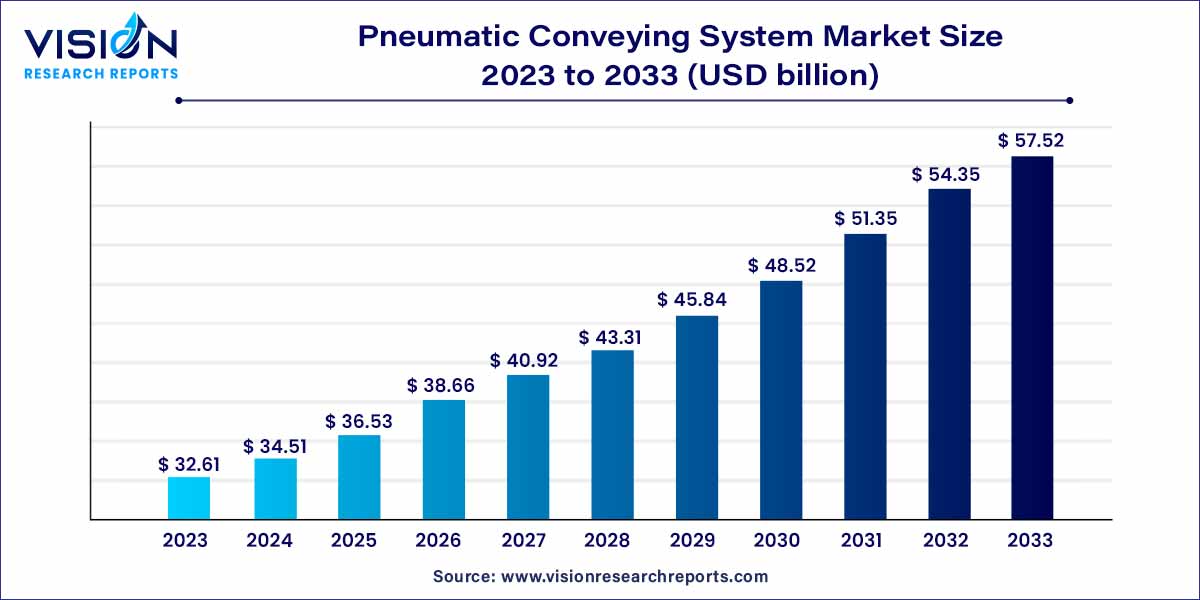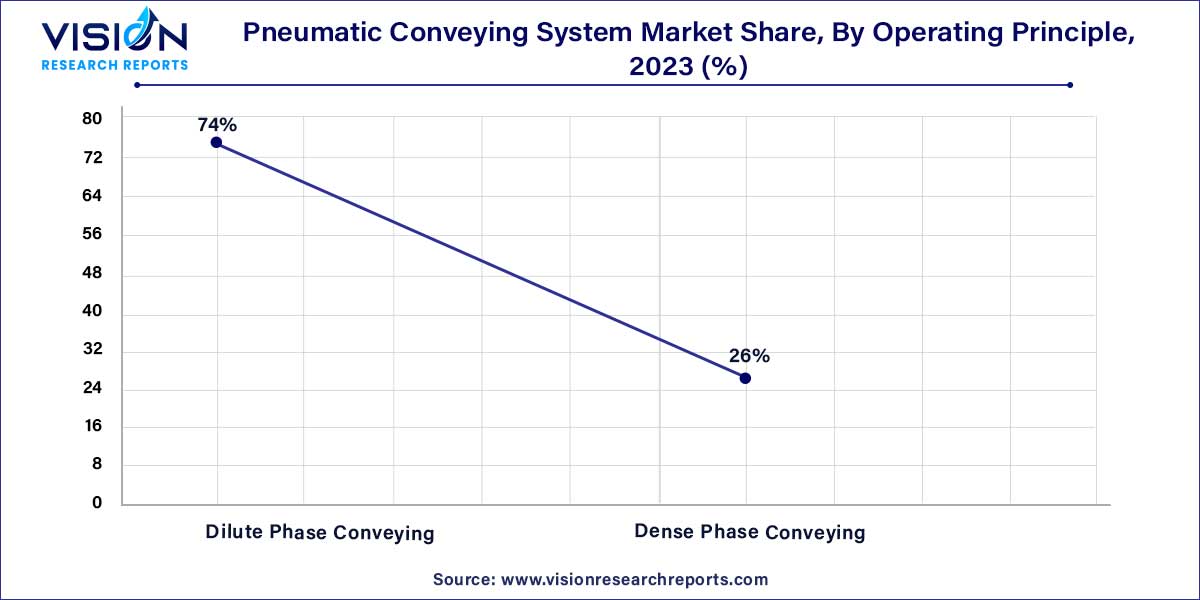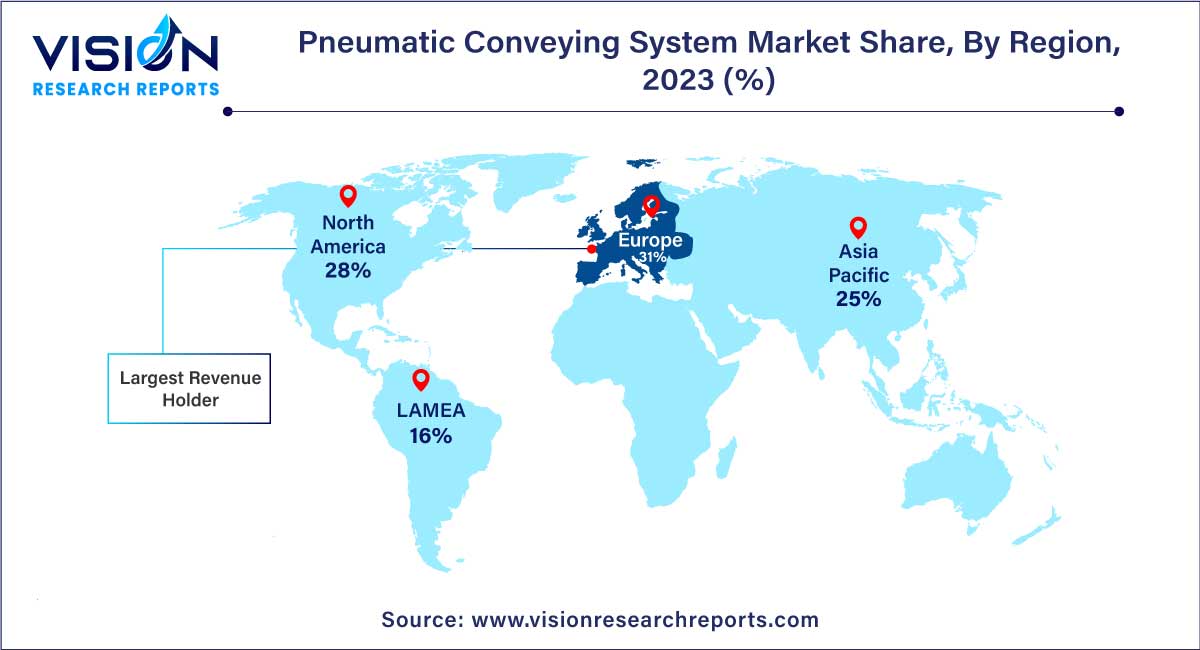The global pneumatic conveying systems market size was estimated at around USD 32.61 billion in 2023 and it is projected to hit around USD 57.52 billion by 2033, growing at a CAGR of 5.84% from 2024 to 2033. The pneumatic conveying systems market is driven by an ongoing trend towards automation in manufacturing processes, rising industrialization, diverse industry applications, and operational cost savings.

The global pneumatic conveying system market has witnessed substantial growth in recent years, driven by the escalating demand for efficient material handling solutions across diverse industries. Pneumatic conveying systems have emerged as integral components, offering a streamlined approach to transport bulk materials, powders, and granules in a highly efficient and cost-effective manner.
The pneumatic conveying system market is experiencing robust growth, propelled by several key factors. The escalating demand for efficient material handling solutions across diverse industries, including food and beverage, pharmaceuticals, and chemicals, is a primary growth driver. As global industrialization continues to expand, the adoption of pneumatic conveying systems becomes integral to enhancing productivity and ensuring seamless material transfer. Furthermore, the pursuit of automation in manufacturing processes has contributed significantly to the market's upward trajectory. Pneumatic conveying systems, with their ability to automate material transfer and minimize human intervention, align perfectly with the contemporary need for streamlined and efficient operations. Stringent safety and environmental regulations further underscore the importance of these systems, as they play a crucial role in minimizing spillage and dust emissions, ensuring compliance with regulatory standards. The market is poised for continued growth as it embraces advancements such as the integration of IoT and Industry 4.0 technologies, emphasizing smart sensors and data analytics for enhanced system monitoring and predictive maintenance. Additionally, a growing focus on energy efficiency is expected to drive innovation, making pneumatic conveying systems more sustainable and environmentally friendly.
The pneumatic conveying systems market is categorized based on its operating principle into dilute phase conveying and dense phase conveying. In 2023, the dilute phase conveying segment held the largest revenue share of 74%. This segment is poised to continue expanding at a CAGR of 5.9% throughout the forecast period.
Pneumatic conveying systems employing the dilute phase operating principle are projected to witness substantial growth in the coming years. These systems find extensive use in industries where continuous conveying is essential, and concerns about material deterioration and abrasion are minimal. Dilute phase pneumatic conveyors are particularly well-suited for transporting low-density, non-fragile, and non-abrasive materials. Recognized for their cost-effectiveness, versatility, and simplicity, they are gaining popularity, especially in high-pressure settings.

On the other hand, the dense phase conveying segment is expected to experience a remarkable CAGR of 27.05% during the forecast period. Pneumatic conveying systems operating on dense phase principles represent the ideal solution for transferring friable or abrasive materials at low or high rates. These systems operate at low speeds and air volumes, preventing the breakdown of fragile materials and mixtures, thus making them indispensable across various industries. Consequently, the demand for dense phase conveying systems is anticipated to exhibit significant growth in the forecast period.
The pneumatic conveying systems market is segmented based on technology into positive pressure, vacuum, and combination systems. In 2023, the positive pressure system segment had the largest market share of 50% and is expected to demonstrate growth throughout the forecast period. This expansion can be attributed to the positive pressure systems' capability to operate at higher pressures compared to other conveying systems. Moreover, their suitability for transporting heavy materials over extended distances stands out as a key factor expected to propel market growth in the forecast period.
Vacuum systems, employing high vacuum pumps that are easy to design and require minimal maintenance, are anticipated to register a CAGR of 5.83% over the forecast period. This projection is driven by the system's capacity to utilize vacuum pressure for precise material positioning at desired stack points, along with its ability to convey materials from multiple sources to a single destination
The pneumatic conveying systems market is categorized by end-use into ceramic, pharmaceuticals, food, rubber and plastic, cement, mining (mineral), and others. In 2023, the food industry generated the maximum market share of 29%. Pneumatic conveyors are becoming increasingly popular in this sector due to their numerous advantages, including high reliability, enhanced productivity, reduced risk of material spillage, low energy consumption, and cost-effectiveness in both operations and maintenance.
The residential segment is poised for substantial growth during the forecast period. The surge in disposable income, coupled with lower housing interest rates in emerging economies, is expected to positively impact market expansion. Furthermore, the rapid urbanization observed in tier-II cities across emerging economies is projected to drive the demand for architectural services, particularly in the context of smart city projects. As architects seek to better manage these projects, the demand for services such as urban planning and project management is anticipated to rise.
In 2023, Europe region dominated the market with the largest market share of 31%. The regional market is poised for significant growth throughout the forecast period, driven by an increasing demand for hygienic methods within the food transfer and production industry. The Food Industry & Drug Administration (FDA) has implemented various regulations addressing indirect contaminants in food, which is expected to positively impact the pneumatic conveying systems market in the region.

Asia Pacific is anticipated to exhibit the highest CAGR of 6.35% over the forecast period. The thriving pharmaceutical industry in the Asia Pacific region is projected to contribute to the increased demand for pneumatic conveying systems. The region has witnessed a substantial rise in facilities dedicated to the production of biosimilars and vaccines, particularly in economically developing nations. Governments in these countries have actively promoted practices that enhance healthcare facilities and the overall development of associated industries. This proactive approach has created a notable surge in growth opportunities, attracting pharmaceutical manufacturers to invest in emerging countries.
By Operating Principle
By Technology
By End-Use
By Region
Chapter 1. Introduction
1.1. Research Objective
1.2. Scope of the Study
1.3. Definition
Chapter 2. Research Methodology
2.1. Research Approach
2.2. Data Sources
2.3. Assumptions & Limitations
Chapter 3. Executive Summary
3.1. Market Snapshot
Chapter 4. Market Variables and Scope
4.1. Introduction
4.2. Market Classification and Scope
4.3. Industry Value Chain Analysis
4.3.1. Raw Material Procurement Analysis
4.3.2. Sales and Distribution Operating Principle Analysis
4.3.3. Downstream Buyer Analysis
Chapter 5. COVID 19 Impact on Pneumatic Conveying System Market
5.1. COVID-19 Landscape: Pneumatic Conveying System Industry Impact
5.2. COVID 19 - Impact Assessment for the Industry
5.3. COVID 19 Impact: Global Major Government Policy
5.4. Market Trends and Opportunities in the COVID-19 Landscape
Chapter 6. Market Dynamics Analysis and Trends
6.1. Market Dynamics
6.1.1. Market Drivers
6.1.2. Market Restraints
6.1.3. Market Opportunities
6.2. Porter’s Five Forces Analysis
6.2.1. Bargaining power of suppliers
6.2.2. Bargaining power of buyers
6.2.3. Threat of substitute
6.2.4. Threat of new entrants
6.2.5. Degree of competition
Chapter 7. Competitive Landscape
7.1.1. Company Market Share/Positioning Analysis
7.1.2. Key Strategies Adopted by Players
7.1.3. Vendor Landscape
7.1.3.1. List of Suppliers
7.1.3.2. List of Buyers
Chapter 8. Global Pneumatic Conveying System Market, By Operating Principle
8.1. Pneumatic Conveying System Market, by Operating Principle, 2024-2033
8.1.1 Dilute Phase Conveying
8.1.1.1. Market Revenue and Forecast (2021-2033)
8.1.2. Dense Phase Conveying
8.1.2.1. Market Revenue and Forecast (2021-2033)
Chapter 9. Global Pneumatic Conveying System Market, By Technology
9.1. Pneumatic Conveying System Market, by Technology, 2024-2033
9.1.1. Positive Pressure Systems
9.1.1.1. Market Revenue and Forecast (2021-2033)
9.1.2. Vacuum Systems
9.1.2.1. Market Revenue and Forecast (2021-2033)
9.1.3. Combination Systems
9.1.3.1. Market Revenue and Forecast (2021-2033)
Chapter 10. Global Pneumatic Conveying System Market, By End-Use
10.1. Pneumatic Conveying System Market, by End-Use, 2024-2033
10.1.1. Ceramic
10.1.1.1. Market Revenue and Forecast (2021-2033)
10.1.2. Pharmaceuticals
10.1.2.1. Market Revenue and Forecast (2021-2033)
10.1.3. Food Industry
10.1.3.1. Market Revenue and Forecast (2021-2033)
10.1.4. Rubber and Plastic Industry
10.1.4.1. Market Revenue and Forecast (2021-2033)
10.1.5. Cement
10.1.5.1. Market Revenue and Forecast (2021-2033)
10.1.6. Mining (Mineral)
10.1.6.1. Market Revenue and Forecast (2021-2033)
10.1.7. Automotive
10.1.7.1. Market Revenue and Forecast (2021-2033)
10.1.8. Others
10.1.8.1. Market Revenue and Forecast (2021-2033)
Chapter 11. Global Pneumatic Conveying System Market, Regional Estimates and Trend Forecast
11.1. North America
11.1.1. Market Revenue and Forecast, by Operating Principle (2021-2033)
11.1.2. Market Revenue and Forecast, by Technology (2021-2033)
11.1.3. Market Revenue and Forecast, by End-Use (2021-2033)
11.1.4. U.S.
11.1.4.1. Market Revenue and Forecast, by Operating Principle (2021-2033)
11.1.4.2. Market Revenue and Forecast, by Technology (2021-2033)
11.1.4.3. Market Revenue and Forecast, by End-Use (2021-2033)
11.1.5. Rest of North America
11.1.5.1. Market Revenue and Forecast, by Operating Principle (2021-2033)
11.1.5.2. Market Revenue and Forecast, by Technology (2021-2033)
11.1.5.3. Market Revenue and Forecast, by End-Use (2021-2033)
11.2. Europe
11.2.1. Market Revenue and Forecast, by Operating Principle (2021-2033)
11.2.2. Market Revenue and Forecast, by Technology (2021-2033)
11.2.3. Market Revenue and Forecast, by End-Use (2021-2033)
11.2.4. UK
11.2.4.1. Market Revenue and Forecast, by Operating Principle (2021-2033)
11.2.4.2. Market Revenue and Forecast, by Technology (2021-2033)
11.2.4.3. Market Revenue and Forecast, by End-Use (2021-2033)
11.2.5. Germany
11.2.5.1. Market Revenue and Forecast, by Operating Principle (2021-2033)
11.2.5.2. Market Revenue and Forecast, by Technology (2021-2033)
11.2.5.3. Market Revenue and Forecast, by End-Use (2021-2033)
11.2.6. France
11.2.6.1. Market Revenue and Forecast, by Operating Principle (2021-2033)
11.2.6.2. Market Revenue and Forecast, by Technology (2021-2033)
11.2.6.3. Market Revenue and Forecast, by End-Use (2021-2033)
11.2.7. Rest of Europe
11.2.7.1. Market Revenue and Forecast, by Operating Principle (2021-2033)
11.2.7.2. Market Revenue and Forecast, by Technology (2021-2033)
11.2.7.3. Market Revenue and Forecast, by End-Use (2021-2033)
11.3. APAC
11.3.1. Market Revenue and Forecast, by Operating Principle (2021-2033)
11.3.2. Market Revenue and Forecast, by Technology (2021-2033)
11.3.3. Market Revenue and Forecast, by End-Use (2021-2033)
11.3.4. India
11.3.4.1. Market Revenue and Forecast, by Operating Principle (2021-2033)
11.3.4.2. Market Revenue and Forecast, by Technology (2021-2033)
11.3.4.3. Market Revenue and Forecast, by End-Use (2021-2033)
11.3.5. China
11.3.5.1. Market Revenue and Forecast, by Operating Principle (2021-2033)
11.3.5.2. Market Revenue and Forecast, by Technology (2021-2033)
11.3.5.3. Market Revenue and Forecast, by End-Use (2021-2033)
11.3.6. Japan
11.3.6.1. Market Revenue and Forecast, by Operating Principle (2021-2033)
11.3.6.2. Market Revenue and Forecast, by Technology (2021-2033)
11.3.6.3. Market Revenue and Forecast, by End-Use (2021-2033)
11.3.7. Rest of APAC
11.3.7.1. Market Revenue and Forecast, by Operating Principle (2021-2033)
11.3.7.2. Market Revenue and Forecast, by Technology (2021-2033)
11.3.7.3. Market Revenue and Forecast, by End-Use (2021-2033)
11.4. MEA
11.4.1. Market Revenue and Forecast, by Operating Principle (2021-2033)
11.4.2. Market Revenue and Forecast, by Technology (2021-2033)
11.4.3. Market Revenue and Forecast, by End-Use (2021-2033)
11.4.4. GCC
11.4.4.1. Market Revenue and Forecast, by Operating Principle (2021-2033)
11.4.4.2. Market Revenue and Forecast, by Technology (2021-2033)
11.4.4.3. Market Revenue and Forecast, by End-Use (2021-2033)
11.4.5. North Africa
11.4.5.1. Market Revenue and Forecast, by Operating Principle (2021-2033)
11.4.5.2. Market Revenue and Forecast, by Technology (2021-2033)
11.4.5.3. Market Revenue and Forecast, by End-Use (2021-2033)
11.4.6. South Africa
11.4.6.1. Market Revenue and Forecast, by Operating Principle (2021-2033)
11.4.6.2. Market Revenue and Forecast, by Technology (2021-2033)
11.4.6.3. Market Revenue and Forecast, by End-Use (2021-2033)
11.4.7. Rest of MEA
11.4.7.1. Market Revenue and Forecast, by Operating Principle (2021-2033)
11.4.7.2. Market Revenue and Forecast, by Technology (2021-2033)
11.4.7.3. Market Revenue and Forecast, by End-Use (2021-2033)
11.5. Latin America
11.5.1. Market Revenue and Forecast, by Operating Principle (2021-2033)
11.5.2. Market Revenue and Forecast, by Technology (2021-2033)
11.5.3. Market Revenue and Forecast, by End-Use (2021-2033)
11.5.4. Brazil
11.5.4.1. Market Revenue and Forecast, by Operating Principle (2021-2033)
11.5.4.2. Market Revenue and Forecast, by Technology (2021-2033)
11.5.4.3. Market Revenue and Forecast, by End-Use (2021-2033)
11.5.5. Rest of LATAM
11.5.5.1. Market Revenue and Forecast, by Operating Principle (2021-2033)
11.5.5.2. Market Revenue and Forecast, by Technology (2021-2033)
11.5.5.3. Market Revenue and Forecast, by End-Use (2021-2033)
Chapter 12. Company Profiles
12.1. Atlas Copco AB.
12.1.1. Company Overview
12.1.2. Product Offerings
12.1.3. Financial Performance
12.1.4. Recent Initiatives
12.2. Coperion GmbH.
12.2.1. Company Overview
12.2.2. Product Offerings
12.2.3. Financial Performance
12.2.4. Recent Initiatives
12.3. Cyclonaire Corporation.
12.3.1. Company Overview
12.3.2. Product Offerings
12.3.3. Financial Performance
12.3.4. Recent Initiatives
12.4. Dongyang P & F.
12.4.1. Company Overview
12.4.2. Product Offerings
12.4.3. Financial Performance
12.4.4. Recent Initiatives
12.5. Dynamic Air Inc.
12.5.1. Company Overview
12.5.2. Product Offerings
12.5.3. Financial Performance
12.5.4. Recent Initiatives
12.6. Flexicon Corporation
12.6.1. Company Overview
12.6.2. Product Offerings
12.6.3. Financial Performance
12.6.4. Recent Initiatives
12.7. Gericke AG.
12.7.1. Company Overview
12.7.2. Product Offerings
12.7.3. Financial Performance
12.7.4. Recent Initiatives
12.8. Nol-Tec Systems Inc.
12.8.1. Company Overview
12.8.2. Product Offerings
12.8.3. Financial Performance
12.8.4. Recent Initiatives
12.9. VAC-U-MAX.
12.9.1. Company Overview
12.9.2. Product Offerings
12.9.3. Financial Performance
12.9.4. Recent Initiatives
12.10. Schenck Process Holding GmbH
12.10.1. Company Overview
12.10.2. Product Offerings
12.10.3. Financial Performance
12.10.4. Recent Initiatives
Chapter 13. Research Methodology
13.1. Primary Research
13.2. Secondary Research
13.3. Assumptions
Chapter 14. Appendix
14.1. About Us
14.2. Glossary of Terms
 Cross-segment Market Size and Analysis for
Mentioned Segments
Cross-segment Market Size and Analysis for
Mentioned Segments
 Additional Company Profiles (Upto 5 With No Cost)
Additional Company Profiles (Upto 5 With No Cost)
 Additional Countries (Apart From Mentioned Countries)
Additional Countries (Apart From Mentioned Countries)
 Country/Region-specific Report
Country/Region-specific Report
 Go To Market Strategy
Go To Market Strategy
 Region Specific Market Dynamics
Region Specific Market Dynamics Region Level Market Share
Region Level Market Share Import Export Analysis
Import Export Analysis Production Analysis
Production Analysis Others
Others